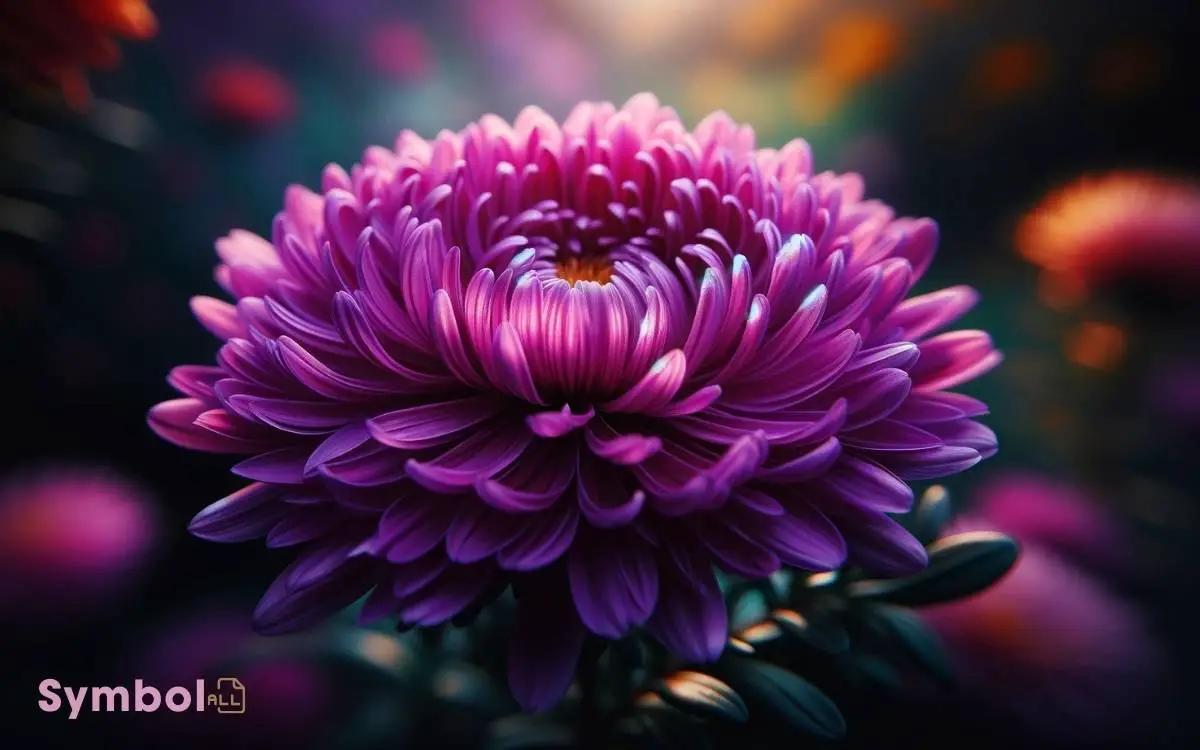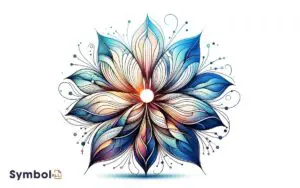What Does the Aster Flower Symbolize? Asters!
Asters are more than just pretty faces; they carry depth in symbolism that traces back to Ancient Greece. You’ll find them echoing love, as they wept from the goddess Astraea, alongside embodying purity and immortality.
Their intricate relation to memory, especially of lost loves, underlines a complex emotional landscape. Unrequited love finds a mirror in asters, symbolizing the endurance and persistence of affection, alongside hope.
Wisdom, valor, and a connection to the magical these blooms aren’t merely decorative; they’re steeped in layers of meaning, from honoring wisdom to serving as protective charms. Explore further, and you’ll discover even richer depths to their beauty and significance.

Key Takeaways
The Origins of Aster
Tracing back to Ancient Greece, the aster flower holds a rich history intertwined with mythology and symbolism, embodying eternal love and wisdom.
This perennial, belonging to the Asteraceae family, thrives across various climates, showcasing its adaptability and resilience.
The name ‘aster’ derives from the Greek word for ‘star,’ reflecting its star-shaped flower head. Scientifically, asters exhibit a composite flower structure, where what appears to be a single flower is actually a cluster of tiny florets.
These florets are categorized into two types: ray florets, forming the outer petals, and disc florets, clustered at the center.
This intricate arrangement facilitates efficient pollination, attracting a diverse range of pollinators. Asters’ widespread distribution and ecological role underscore their significance beyond mere aesthetic appeal.
Symbolism in Greek Mythology
In Greek mythology, the aster flower is deeply imbued with symbolic meaning, representing not only love but also the tears of the goddess Astraea, who wept for the stars dimmed by daylight.
To draw you further into the depth of its symbolism:
- Purity: Asters are symbols of purity, mirroring Astraea’s virtuous nature.
- Immortality: Their star-like shape connects them to the eternal night sky, symbolizing immortality.
- Remembrance: Asters are associated with the memory of lost loves, not in a sorrowful way, but as a celebration of enduring affection.
- Guidance: Just as stars guide travelers, asters symbolize guidance for the soul, leading one towards a destined path of enlightenment and understanding.
This intricate symbolism showcases the aster’s rich heritage within Greek mythology, offering profound insights into its cultural significance.
Asters and Unrequited Love
Delving into the domain of unrequited love, asters symbolize the complex emotions tied to love that isn’t reciprocated, highlighting their significance in the nuanced tapestry of human relationships.
These flowers, with their myriad hues and intricate layers, mirror the depth and multifaceted nature of feelings that go unacknowledged or unreturned.
Asters aren’t merely decorative; they carry a profound message about the endurance and persistence of affection, even in the absence of mutual sentiment.
In the scientific sphere, the study of plant symbolism, known as phytosemiotics, underscores the role of asters in expressing these subtle yet intense emotional states.
Their presence in bouquets or gardens subtly conveys a message of hope and longing, serving as a poignant reminder of love’s complexities and the resilience of the human heart in the face of unreciprocated feelings.
Wisdom and Valor Representation
Exploring the symbolic dimensions of asters further, they also embody wisdom and valor, reflecting ancient beliefs in their capacity to communicate these virtues.
Here’s how:
- Ancient Greek Lore: Asters are steeped in Greek mythology, symbolizing the tears of the Greek goddess, Astraea, embodying divine wisdom and valor in battles.
- Medicinal Uses: Historically, asters were used in medicine, believed to restore mental clarity and courage, thereby linking them to wisdom and bravery.
- Floral Language: In Victorian floriography, asters convey a message of trust and valor, appreciated by those seeking to communicate respect for someone’s wisdom and courage.
- Cultural Significance: Various cultures have adopted the aster as a symbol of honor and wisdom, often placed on graves to signify a life lived with valor and intellect.
Connection to Magical Practices
You’ll find that the aster flower holds a significant role in magical rituals, often incorporated for its believed potent energies.
It’s commonly used as a protective charm, thought to ward off negative forces and enhance the effectiveness of spiritual practices.
This connection to magical practices is rooted in historical and cultural beliefs, highlighting the aster’s multifaceted significance beyond its beauty.
Magical Rituals Inclusion
Asters have been deeply intertwined with magical rituals, serving as a potent symbol for protection and enchanting love spells. Their inclusion in such practices isn’t arbitrary; it’s rooted in their inherent properties and historical significance.
To understand their role, consider the following aspects:
- Phytochemistry: Compounds within asters, such as sesquiterpenes and flavonoids, have been linked to various bioactivities, including anti-inflammatory and antimicrobial effects, which may contribute to their perceived magical properties.
- Symbolism: Asters are symbolically associated with Venus, the Roman goddess of love, enhancing their use in love spells.
- Historical Usage: Historical texts and folklore often reference asters in rituals aimed at warding off evil spirits or summoning positive energy.
- Cultural Significance: Different cultures have attributed unique magical qualities to asters, ranging from healing powers to the ability to facilitate communication with the spiritual domain.
Protective Charm Uses
Throughout history, people have harnessed the protective qualities of aster flowers in magical practices, leveraging their bioactive compounds for warding off negative energies.
These flowers contain flavonoids and sesquiterpenes, compounds known for their potent antioxidant and anti-inflammatory properties.
In the domain of protective charms, asters aren’t just chosen for their vibrant beauty; they’re selected for their energetic properties, believed to create a shield against spiritual harm.
You’ll find asters incorporated into amulets and talismans, often dried and encased in protective sachets. These are then placed in homes or carried on one’s person to repel evil spirits and attract positive, protective energies.
This practice, deeply rooted in folklore, combines an understanding of plant science with mystical traditions, offering a holistic approach to spiritual protection.
Asters in Victorian Flower Language
In the intricate language of Victorian flowers, asters hold a special significance, symbolizing love and patience.
This era, marked by its own codified way of expressing emotions, saw flowers as messengers of sentiments unspoken. Asters, with their star-shaped flowers, played a pivotal role within this botanical vernacular.
Here’s why you should consider the aster within this framework:
- Love’s Emblem: Asters were often used to signify a love that’s patient and enduring.
- Diverse Meanings: Depending on their color, asters could communicate different layers of affection and admiration.
- Secret Messages: Sending asters was a discreet way of declaring one’s feelings, a practice cherished in Victorian society.
- Cultural Significance: Beyond love, these flowers also represented wisdom and valor, enriching their value in floral conversations.
Patience and Elegance Embodied
You’ll find the aster flower embodies patience not just through its growth cycle but also in the way it interacts within its ecosystem, supporting various pollinators over extended periods.
Its elegance is manifest in the intricate structure of its blooms, where each petal is positioned with precision, contributing to the flower’s overall aesthetic appeal.
This botanical masterpiece reveals a timeless beauty, a sign of the enduring allure of the aster in both natural and cultivated settings.
Symbolic Patience Meaning
Often, the aster flower embodies the virtues of patience and elegance, signaling a profound connection between time and beauty in the natural world.
This connection is deeply rooted in the flower’s biology and cultural interpretations, offering insights into its symbolic patience meaning.
- Growth Cycle: Asters bloom in late summer to fall, requiring months of growth before revealing their beauty. This mirrors the virtue of patience waiting for the right moment.
- Resilience: They thrive in varied climates, symbolizing endurance and the patience to overcome adversities.
- Cultivation: Asters demand nurturers to be patient, as they develop and flourish over time.
- Adaptability: Their ability to adapt to different environments reflects the patience required to find beauty regardless of circumstances.
Understanding these aspects, you’ll appreciate not just the aster’s aesthetic but its profound patience symbolism.
Elegance in Blooms
Asters, through their delicate form and vibrant hues, epitomize the essence of elegance and patience, showcasing how time meticulously sculpts beauty in the natural domain.
Their evolution, from bud to bloom, mirrors a journey of maturation where each petal unfolds at its own pace, revealing a masterpiece of nature’s design.
You’ll find that asters are not just flowers, but symbols of sophisticated beauty that flourishes over time.
| Characteristic | Description |
|---|---|
| Form | Delicate, layered petals |
| Hues | Spectrum from deep purple to soft pink |
| Growth | Slow, patient development |
| Symbolism | Elegance and patience |
This intricate process, where each aspect of the aster’s growth contributes to its final elegance, mirrors life’s own patience-demanding journey toward beauty and sophistication.
Timeless Beauty Revealed
Through the lens of time, we observe asters as they embody the quintessence of patience and elegance, unraveling their beauty in a slow yet deliberate manner.
This process showcases several key aspects:
- Growth Cycle: Asters follow a unique growth pattern, patiently waiting for the right conditions to bloom, often late in the season when other flowers have faded.
- Adaptability: Their ability to thrive in varied climates speaks to their elegant resilience, adapting to guarantee survival and beauty.
- Pollination Process: Asters play an essential role in the ecosystem, attracting pollinators long after other flowers have disappeared, showcasing a symbiotic relationship of patience and provision.
- Longevity: With proper care, some aster species can exhibit their elegant blooms for an extended period, embodying the concept of timeless beauty.
Asters as Birth Flowers
Did you know that asters are the birth flowers for those born in September, symbolizing wisdom, valor, and faith? This association stems from their late blooming cycle, often flourishing when most other flowers have completed their life cycle.
The resilience and beauty of asters in the face of the changing seasons mirror the qualities of wisdom and valor.
Their wide range of colors, mainly purple, further enhances their symbolic meaning, with purple often associated with royalty and spirituality, thereby highlighting the attribute of wisdom.
Their intricate, star-shaped petals are believed to represent faith, a guiding light in the darkness. For those born in September, the aster not only marks their birth month but also embodies the profound qualities they’re believed to possess.
Varieties and Their Unique Meanings
Delving into the world of aster flowers, you’ll discover a fascinating array of varieties, each bearing its own unique symbolism and significance.
Here are four remarkable types:
- New England Aster (Symphyotrichum novae-angliae): Symbolizes independence. Its robust nature and vibrant purple blossoms resonate with the spirit of self-reliance and resilience.
- Alpine Aster (Aster alpinus): Represents patience. Native to the mountains, this variety’s ability to thrive in harsh conditions underscores a message of endurance and perseverance.
- Heath Aster (Symphyotrichum ericoides): Embodies good wishes. With its sprawling sea of tiny white flowers, it conveys a blanket of positive intentions.
- China Aster (Callistephus chinensis): Signifies remembrance. Often found in memorial gardens, its diverse and vivid hues evoke memories of past companionship.
Asters in Modern Culture
Building on the understanding of aster varieties and their meanings, let’s explore the role of asters in modern culture, where these flowers continue to hold significant symbolic value.
Asters aren’t just botanical specimens; they’re cultural icons, embodying deep-seated beliefs and emotions.
In contemporary ceremonies, asters often symbolize remembrance and are used in arrangements to honor loved ones, reflecting their historical association with the Greek word for ‘star.’
Their presence in modern floral language extends to symbolizing wisdom, a nod to their mythological roots.
Scientifically, asters contribute to biodiversity, supporting ecosystems by providing nectar for pollinators. This ecological role underscores their importance beyond aesthetics, highlighting their contribution to environmental sustainability.
Asters, thus, stand at the intersection of culture, emotion, and science, enriching human and ecological communities alike.
Incorporating Asters in Daily Life
Incorporating asters into your daily life can enhance both your home environment and personal well-being through their diverse colors, shapes, and ecological benefits.
Here’s how you can integrate these vibrant flowers effectively:
- Gardening: Planting asters attracts beneficial pollinators, supporting local ecosystems. Their hardiness across zones 3-8 makes them versatile for various climates.
- Floral Arrangements: Asters’ wide color palette and long vase life enrich indoor aesthetics and mood, offering visual and psychological uplift.
- Natural Remedies: Historically, asters have been used in traditional medicine for their anti-inflammatory properties, providing a natural option for skin and respiratory ailments.
- Eco-friendly Practices: Opt for native aster species in your garden to promote biodiversity and reduce water usage, aligning with sustainable gardening principles.
Conclusion
Fundamentally, asters aren’t just a feast for the eyes but a whisper from the universe, cloaked in petals.
They’re nature’s cryptic messengers, embodying tales of unspoken passions, the bravery of silent battles, and the wisdom of the ancients.
Whether marking the journey of stars or weaving magic in the mundane, asters invite you to embrace their multifaceted meanings.
Let them be a reminder of the delicate balance between visible beauty and hidden depths, urging you to explore beyond the surface.






